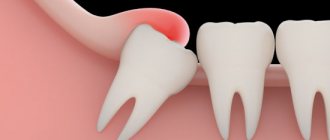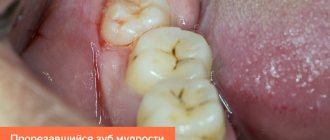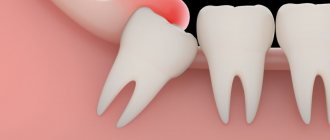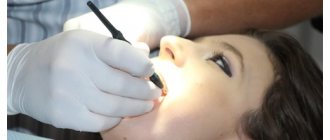For most people, the growth of wisdom teeth is accompanied not only by gum cutting and discomfort, but also by quite severe pain that makes it difficult to eat, concentrate on any task, and even sleep.
If the wisdom tooth grows and does not cause significant discomfort, no medical action may be taken. As a rule, the discomfort goes away after 1-2 weeks, but in order to avoid the manifestation of other problems, it is worth undergoing an examination at a dental clinic. However, if the gums from the wisdom tooth become inflamed, the local and general temperature rises, and specific aching pain is felt, immediately contact your dentist, he will conduct an examination and take the necessary measures to eliminate the problem.
Symptoms of wisdom tooth growth
During the period when a wisdom tooth comes in, a number of specific symptoms can be observed, by which it can be determined that the discomfort comes specifically from the eights:
- Discomfortable sensations in the tooth area, in some cases – gum thickening;
- Feeling of swelling in the gums;
- Increased local temperature, painful swelling;
- In the molar area, soft tissues (gums) become inflamed;
- Difficulty opening the mouth and swallowing. When opened wide, a sharp, aching pain is felt;
- There is a desire to chew any hard food or objects. After such chewing, the pain increases significantly;
- General increase in body temperature, general malaise and headaches.
Depending on the nature of growth, pain in wisdom teeth and specific symptoms can vary significantly. Regardless of how long a wisdom tooth grows - one or two weeks, it will cause certain sensations, and in case of complex or pathological growth - acute pain with inflammation of the gums.
An increase in general body temperature and swelling of the cheek indicates a severe course, as well as the possible development of pericoronitis - a complex disease of the oral cavity with a number of consequences.
How to understand that wisdom teeth are growing abnormally
Signs or symptoms that indicate problems include the following:
- numbness of the jaw and painful sensations - in this case we can say that the tooth is growing crookedly inside the bone and even injures the jaw nerve,
- sharp pain throughout the jaw, but more so near the base (where the temporomandibular joint is located),
- Above the figure eight, the gum is swollen, moves away from the surface, is red and very painful,
- the lymph nodes become inflamed and increase in size - this indicates the addition of an infectious process,
- the teeth in the row begin to shift - often this may not be noticeable to the person himself, but the doctor will see the changes after performing a panoramic x-ray,
- Due to the lack of space for quality hygiene, a carious cavity appears behind the wisdom teeth or gum disease begins to develop.
The main causes of pain
Painful symptoms from wisdom teeth are caused by the anatomical features of the upper and lower jaw, which are already fully formed in a person at the age of 17-25.
As the figure eight begins to grow, it puts pressure on neighboring teeth, bone and soft tissue. The growth process can last for months and even years, so pain manifestations are temporary, periodically fading and exacerbating.
The pain of tooth 8 can be provoked not only by its growth or anatomically incorrect position, but also by the presence of various pathologies, for example, caries, pulpitis, periodontitis or a wide range of infectious diseases. Note! The lack of timely professional help can provoke a worsening of the situation, which will result in the need to remove the diseased tooth and treat complications.
Possible complications during the development of wisdom teeth dystopia
Third molars are extremely problematic teeth. If teething occurs with tolerable pain and the patient does not rush to the dentist, then the following complications are possible:
- Pericoronitis – inflammation of the gum mucosa;
- A follicular cyst is a “sac” of fluid pressing on the roots;
- Periostitis is inflammation and suppuration (abscess) of the periosteum.
The appearance of these complications will lead to longer, more painful and expensive treatment, so you should not put off going to the doctor if you feel that your wisdom tooth has begun to erupt.
How to relieve pain if a wisdom tooth grows and your gums hurt.
The growth of wisdom teeth is not painless for every person, so most people need to know what to do in case of inflammation of the gums around the wisdom tooth and acute aching pain.
If there is inflammation, pain, or if the cheek is swollen near the wisdom tooth, you should contact your dentist, he will conduct an examination and take the necessary measures to eliminate symptomatic manifestations.
If the pain begins in the evening or it is not possible to quickly contact a specialized specialist, doctors recommend several ways to reduce pain:
- Rinse the growth with calendula tincture after eating - this will reduce the intensity of the inflammatory process and also reduce pain;
- Rinse your mouth with a solution of baking soda in water, at the rate of 1 teaspoon of soda per 1 glass of water (200 grams) - soda calms inflammation and also reduces pain;
- To rinse the mouth, you can use decoctions of chamomile, oak bark, chicory root, as well as sage tincture and propolis;
- Anti-inflammatory, painkillers and antibacterial drugs - use according to the instructions. They help reduce pain, reduce swelling, and also eliminate the negative bacterial influence at the site of tooth eruption.
In case of acute unbearable pain, as well as the absence of the above remedies, you can use cold water to reduce pain: take a glass of cool water, put a small amount in your mouth and hold it in the area where the wisdom tooth is erupting - this can quickly reduce the level of pain. However, this method has one negative feature - the pain intensifies almost immediately after stopping holding cool water at the site of gum inflammation, for example, near the hood of a wisdom tooth.
Is it painful to have a wisdom tooth removed?
Is wisdom tooth extraction accompanied by pain? This is one of the most common questions.
The fact is that very rarely “eights” grow healthy; usually their eruption causes pathological processes that are dangerous to the patient’s health, so their removal is required. Surgical removal of the “eight” is always accompanied by pain, the process is especially difficult due to curvature and other disorders of the third molar. The procedure must be carried out with the use of painkillers. Most often, dentists use drugs based on articaine - “Ultracaine”, “Ubistezin”. The use of local anesthetics allows you to completely eliminate pain during surgery. However, the process of administering the drug itself may be accompanied by pain. In addition, when the anesthesia wears off (after about 6 hours), intense pain occurs.
Severe pain during the removal of the third molar is inevitable in cases where the patient has not consulted a specialist for a long time, the inflammatory process has started, resulting in purulent formations. Sometimes tooth extraction is performed under general anesthesia. In other situations, surgery is painless.
The upper “eights” are much easier to remove than the lower ones. This feature is due to the fact that wisdom teeth in the lower dentition have more powerful and sinuous roots. To properly carry out the procedure for removing the third molar, the dentist sends the patient for an x-ray before the operation.
Where can I get dental care in Orenburg?
If your gums hurt where your wisdom teeth are, you can get qualified dental care in two places: public and private dental clinics. During the appointment, the dentist must:
- Conduct a preliminary examination of the oral cavity, determine the exact cause of the development of painful symptoms;
- If necessary, refer the patient for an x-ray - this procedure is often necessary in the presence of impacted wisdom teeth (completely or partially covered by gum), as well as in the case of surgical removal;
- Take the necessary measures to reduce or eliminate pain and swelling, as well as prevent further aggravation of the situation;
- If necessary, refer to a dental surgeon to remove third molars;
- Provide recommendations for further dental and oral care.
Do your gums hurt and you have symptoms of wisdom tooth growth? Seek qualified help from specialized specialists!
Useful tips
Before removing an incorrectly positioned wisdom tooth, we offer a number of tips that will help you prepare and go through the operation more comfortably:
- Try to make an appointment for tooth extraction in the morning. During the night, the hormone cortisol accumulates in the body, which helps to survive stressful situations. In addition, one should take into account the fact that the inevitable bleeding from the wound at the site of the former tooth will stop by the evening, and the person will be able to sleep peacefully.
- Eat well before surgery. As a result, saliva will be released in smaller volumes, and then you will need to leave your jaws alone and not eat for some time.
- If possible, immediately use a cold object and periodically apply it to your cheek on the way home to prevent swelling from forming. A pack of dry ice from a motorist's first aid kit will do.
- At home, rinse your mouth with clean water or medications recommended by your doctor.
- Take medications in the correct dosage, do not get carried away with self-medication and self-prescription of drugs.
Recommendations for a better rehabilitation period after removal of an impacted wisdom tooth:
- You will need to allow a blood clot to form at the site of the extracted tooth. His presence is mandatory. The clot protects the socket from the penetration of bacteria and prevents complete deformation of the gums. Dry socket is dangerous and provokes inflammation.
- Do not touch the blood clot with your tongue, toothbrush bristles, or cutlery. It is not even recommended to use mouth rinse for 2-3 days after surgery. It is better to take the medicine into your mouth, hold it for a while and spit, avoiding the chance of dislodging the clot.
- To stop bleeding, it is permissible to use sterile cotton wool or gauze swabs. It is allowed to moisten with Chlorhexidine, Miramistin. It is prohibited to use hydrogen peroxide!
- For several days you will have to eat soft food and maintain an acceptable temperature of food and drinks.
- You are supposed to temporarily give up physical activity and training. Baths and saunas, swimming pools, solariums are prohibited.
- You cannot heat the surgical area, as this will cause a dangerous inflammatory process. You can apply ice, but under no circumstances keep it on your cheek all the time. Optimal rhythm: 5 minutes cooling, 5 minutes break. If you don’t have ice at home, bags of frozen vegetables and meat from the freezer will do.
- Maintaining oral hygiene is not prohibited. The main thing is to leave the operated area alone in the first days and not try to thoroughly clean the teeth located near the wound. Disinfection can be carried out with solutions of Chlorhexidine, Furacilin, holding it in the mouth and spitting it out, without rinsing.
Medicine knows of cases when wisdom teeth are prescribed to be preserved. But if it grows, pushing neighbors, lies horizontally or rests on the roots of nearby teeth, there is no need to think twice. Such an eight is considered problematic and is deleted without regret.
If a wisdom tooth grows horizontally and puts pressure on the adjacent tooth
Removal of wisdom teeth using ultrasound in Moscow without pain and complications
Myth #1: Wisdom teething causes crooked front teeth.
Wisdom teeth (third molars), along with the caudal vertebrae, auricular muscles, appendix and epicanthus, are rudiments, i.e. organs that have lost their basic significance in the process of human evolution.
Millions of years ago, our ancestors needed a massive dentofacial apparatus, consisting of a large number of teeth and capable of withstanding heavy loads. This was determined by the nature of nutrition, consumption of solid and tough food, its production, etc. In the process of evolution, there was an increase in the size of the cerebral part of the skull, a decrease in the shape and size of the jaws and teeth. Therefore, often when the last teeth erupt, there is not enough space in the dentition, as a result of which they erupt incorrectly, occupying a position outside the dental arch.
As the eighth teeth erupt, they put pressure on the ones in front, which subsequently leads to crowding of the anterior group of teeth. This is true, but only partly. In the process of erupting, wisdom teeth, of course, put pressure on the teeth in front, since often they simply do not have enough space in the dentition, but this pressure is not enough to cause crowding of the teeth.
It is important that the vector of eruption of the lower teeth is directed upward and slightly forward. Also, during growth, the lower jaw moves slightly upward, which can change the direction of teeth eruption. The incisors bend posteriorly, more than usual, and the molars erupt slightly anteriorly, which leads to a decrease in the length of the dental arch and does not allow the incisors to “straighten”.
It should be noted that crowding can also occur in people who lack third molar buds. Therefore, the main reason for the appearance of crowded teeth lies in the discrepancy between the size of the teeth and the size of the jaw, which is largely determined by a hereditary factor. Another reason may be the premature loss of primary teeth, which leads to improper eruption of permanent teeth and a decrease in space in the dental arch and subsequently to crowding of permanent teeth.
On the upper jaw, wisdom teeth can grow towards the cheek; this direction injures the mucous membrane and does not allow normal cleaning of this space with a toothbrush, which, in turn, contributes to the deposition of a large amount of plaque, which leads to dental caries. It is also possible to tilt towards the front tooth, which ultimately leads to the same consequences. In such cases, removal of wisdom teeth is required in order to prevent the increase in symptoms of inflammation in the oral cavity.
The rudiments of the eighth teeth are formed, unlike other teeth, after birth and erupt at the age of 18 to 25 years. It should be noted that some people simply do not have the rudiments of wisdom teeth, which, of course, in no way diminishes the level of their mental development, but once again confirms the theory of rudiments.
Tooth extraction is one of the most common operations in dental practice, the outcome of which depends on the correct and complete examination of the patient, at the stage of planning the surgical intervention, determining indications/contraindications, sequential implementation of all stages of tooth extraction and compliance with aseptic rules. It is important to remember the danger and frequency of complications in the postoperative period. Normally, healing of the hole occurs within 1-2 weeks. During this time, the hole is filled with granulation tissue, then osteoid tissue, and subsequently the formation of bone tissue occurs. For our patients, we use a special set of medications, which greatly facilitate the postoperative period and reduce the likelihood of complications.
Sincerely,
Dentist at the Golden Section Clinic
Alexey Anatolyevich Ivanov.
Wisdom tooth: treatment or removal
Treatment of wisdom teeth, as far as possible, is carried out therapeutically. If the walls of the tooth are strong and the nerves are not affected by caries, the tooth is filled in the same way as with other teeth. Treatment of wisdom teeth does not differ from the standard procedure.
If the tooth grows in the wrong position and has curved roots, then the best way to get rid of problems with wisdom teeth is to remove them. Tooth extraction helps to avoid the development of oral diseases and keep the dentition beautiful and straight. If the wisdom tooth has grown correctly and does not cause you any inconvenience, then, of course, there is no need to remove it simply because it is the eighth tooth.











